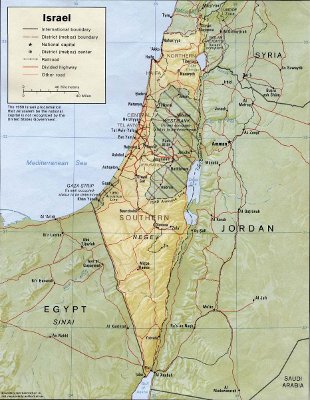Guest Columns
UN Resolution 242, Israel, and confusion

As I pointed out in 1978, UN Resolution 242 requires the application of two principles: “(1) withdrawal of Israel’s armed forces from territories occupied in the war; and (2) the right of every State in the area to live in peace within secure and recognized boundaries free from threats and acts of force.”
UN Resolution 242: does it have that article?
President Obama has emphasized the second principle. But he has failed to mention the exclusion of the definite article “the” preceding the word “territories” in the first. The exclusion of that definite article means – and even the State Department intended it to mean – that Israel need not withdraw from all the territory in question, that is, to pre-1967 borders. This was the understanding of Professor of Law Eugene Rostow, who helped draft UN Resolution 242.
But: “Even if one construed the first principle as requiring Israel to withdraw on all fronts, this principle runs into a geopolitical oxymoron with the second principle.” This is precisely what I said in a December 1978, three months before the March 1979 signing of the Israel-Egyptian peace treaty. So I’m back to repeating what I said more than three decades ago, namely this:
In 1978
By confirming Israel’s right to “secure” and “recognized” boundaries, the second principle is an attempt to square the circle. The simple truth is that “secure” and “recognized” boundaries are antithetical concepts given the ideological character of Israel’s neighbors—despotic on the one hand, and Islamic on the other. Thus, what Israel may reasonably regard as “secure” boundaries, Arab state will not “recognize.”
For example, in a (now declassified) secret memorandum dated June 27, 1967, the U.S. Joint Chiefs of Staff recommended that Israel retain control of the Judean and Samarian mountain ridges overlooking her vulnerable population centers on the coastal plain. The report also recommended that Israel should retain Gaza, the Golan Heights, and a portion of the southern Sinai to secure its access to the Red Sea through the Strait of Tiran.
Despite the geopolitical dilemma involved in “secure” versus “recognized” boundaries, I raised the question: Which of these two politically antithetical concepts takes legal as well as moral precedence?
According to the UN Charter and to international law in general, every nation has an inherent right to self-preservation. But inasmuch as no one is more concerned about a particular nation’s preservation than that nation itself, it follows that each nation must be the ultimate judge of what is required for its preservation. Hence the concept of secure boundaries takes precedence over the concept of recognized boundaries.
Fundamental issues
It may be objected that Israel will not be secure until it has borders recognized by its neighbors. But this begs the fundamental issue. The objection presupposes that the Arab states can be trusted to remain content to have Israel withdraw from Judea, Samaria, Gaza, and the Golan Heights. Yet, despite their professions of peace, Arab states – all dictatorships – can hardly live in abiding peace with each other, much less with the Jewish and democratic state of Israel.
The objection also fails to consider the fact that whereas recognition of international boundaries is primarily a legal matter dependent on the will of others – in this case, the fluctuating will of Arab autocrats – secure and defensible boundaries is primarily a military matter dependent on permanent geographic factors on the one hand, and a nation’s own will and resources on the other.
And today
So much for what I said in 1978. Now, back to Obama who obviously ignores these distinctions. But then, Israel’s own leaders, including Netanyahu, fail to make these distinctions, thanks to their fixation on the policy of land-for-peace. Fixated on the territorial issue, he is mute regarding the more fundamental issue: the cultural and theological animosity of Muslims toward the Jewish state. No politician dares say a word about this.
In fact, addressing a joint session of the US Congress on July 10, 1996, Netanyahu gratuitously denied the obvious, the clash of civilizations between the Muslim-led Palestinian Authority and the Jewish state of Israel. He and his predecessors, animated by “political correctness,” have ignored the bellicose nature of Arab-Islamic culture, acknowledged by former Muslims such as Wafa Sultan and Nonie Darwish.
All this makes UN Resolution 242 an oxymoron having lethal consequences for Israel.◙
-

 Executive4 days ago
Executive4 days agoThe Last Supper: New York’s Socialist Feast
-

 Civilization4 days ago
Civilization4 days agoYoo Hoo, VP Vance—Your Character is Showing!
-

 Civilization5 days ago
Civilization5 days agoIvory Tower Thinking and Narcotics Boats
-

 Civilization15 hours ago
Civilization15 hours agoDC Pipe Bomb Arrest Raises Questions About Christopher’s Wray’s FBI
-

 Guest Columns3 days ago
Guest Columns3 days agoCongressional Leaders See Far Higher Stock Returns Than Peers
-

 Civilization4 days ago
Civilization4 days agoFacing Facts & Rolling Back Mythologies: The New National Security Strategy
-

 Civilization2 days ago
Civilization2 days agoThe Legal Logic Behind U.S. Operations Against Narco-Terrorist Networks
-

 Civilization3 days ago
Civilization3 days agoHow Trump Changed America











